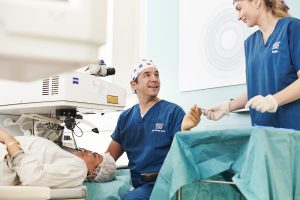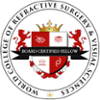A History of LASIK – The Most Common Laser Eye Surgery Procedure

Laser Eye Surgery has arguably become the world’s most popular elective procedure, with over 100,000 treatments being carried out each year in the UK alone. Today, patients may undergo one of a number of Laser Eye Surgery treatments, but one remains by far the most common – LASIK.
We’re taking a closer look at the history of this popular procedure and what makes it ideal for so many people looking to ditch their glasses and contact lenses.
What is LASIK?
LASIK, (Laser-assisted in-situ keratomileusis) is a Laser Eye Surgery technique developed in the 1990s. Like all kinds of Laser Eye Surgery, it works by removing tiny areas of tissue to reshape the cornea. It can be used to correct common refractive errors such as myopia (short-sightedness), hyperopia (long-sightedness), astigmatism, and presbyopia (ageing eyes).
What Came Before LASIK?
LASIK evolved from earlier refractive treatments, starting with José Barraquer Moner’s work in the 1940s and 50s. Moner developed the first method of sculpting the stromal tissue of the cornea in 1948 and successfully treated many patients. However, given the technological restrictions of the time, it was not without its risks.
As the years went on, the procedure continued to develop. At this time, the treatment was a non-laser surgical procedure that relied on microkeratomes (oscillating blades) to remove areas of corneal tissue. Examples of such procedures include Radial Keratotomy, which was used in the late 1970s and 80s.
However, by the late 1980s, the development of laser technology heralded a new age for refractive surgery, and the dawn of Laser Eye Surgery. The fist laser procedure performed was Photorefractive Keratectomy (PRK) using an excimer laser to reshape the cornea. During this procedure, an area of the corneal epithelium was removed to allow access to the tissue beneath. A protective contact lens is then placed over the treatment area to protect it while the epithelium repopulates.
This technique is still used today; however, it is much less common than it was, thanks to the introduction of LASIK.
How Does LASIK Work?
Unlike PRK (and LASEK, another surface procedure), LASIK doesn’t involve the complete removal of corneal epithelium. Instead, a flap is created in the epithelium.
In earlier procedures, this was done using a microkeratome; however, in more modern treatments, a high-precision femtosecond laser is used to create the flap in the cornea. This is known as Bladeless LASIK or all-laser LASIK. This flap is then gently folded back, allowing the surgeon to remove a precise amount of corneal tissue using a second laser – the excimer laser.
Once the treatment is complete, the corneal flap is simply folded back into place, where it begins to heal in just a few hours. The development of this technique minimised disruption to the cornea, resulting in faster recovery times than those of PRK and LASEK.
Still, more advancements were on their way to make Laser Eye Surgery even more effective.
These developments included the development of the Artemis Insight 100 – the most accurate corneal scanner in the world. This technology was developed by our very own founder and dedicated Laser Eye Surgeon, Professor Dan Reinstein. Its introduction allows surgeons to more accurately measure the thickness of the corneas, making for more precise and bespoke treatments for patients.
Then we had the introduction of wavefront technology. This state-of-the-art kit allows us to account for other imperfections in a patient’s eyes, aside from the refractive error. As a result, treatments are now more effective than ever.
At London Vision Clinic, we use the Artemis Insight and wavefront technology, as standard. This ensures every patient can expect the best possible outcomes.
Why Does LASIK Remain So Popular?
While developments – including the minimally-invasive ReLEx SMILE procedure – continued to advance Laser Eye Surgery, LASIK remains the most popular treatment to this day. This is thanks to its widespread suitability for a wide range of patients and prescriptions and patients, and its fast recovery times – most patients are able to return to work the very next day!
Still, there are some situations in which LASIK may not be the best option. In the vast majority of these cases, there is a suitable alternative treatment, including PRK/LASEK and ReLEx SMILE. In fact, at London Vision Clinic, we are able to treat around 97% of the patients we see!
If you’d like to find out if you could be suitable for Laser Eye Surgery – don’t hesitate! Get in touch with one of our friendly clinic coordinators or Book a Consultation today!


